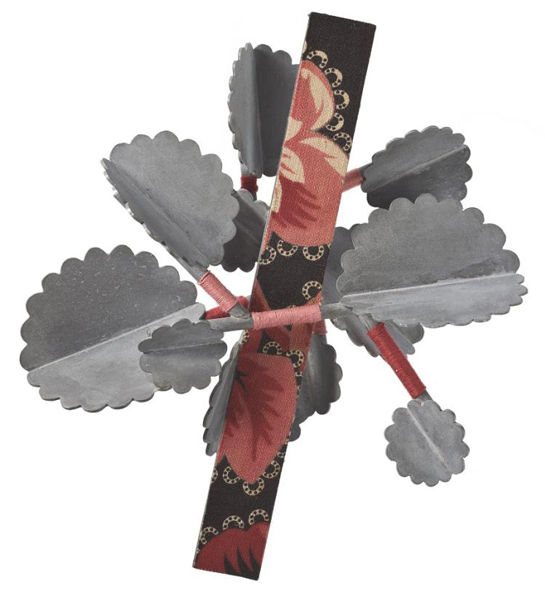
My favorite piece of jewelry
Giovanni Corvaja, Wendy Ramshaw, Gijs Bakker, David Watkins, Fritz Maierhofer, Jan Yager and Kevin Coates are just a few of the important makers represented in National Museums Scotland’s jewelry collection. This amazing collection was mainly acquired by Dr Elizabeth Goring, a colleague and good friend and to whom I am grateful for her generously given help and advice when I began curating the collection.
I thought long and hard about which piece I should choose. There were many candidates and a great many reasons attached to the contenders but in the end, surprisingly, my favorite piece is not one of the seminal works acquired by Liz but a brooch by Lucy Sarneel. I first saw Lucy’s work at Collect, the London Art fair, in 2007 where she was being shown at Galerie Marzee and was I was stuck by both the simplicity of her work and the exquisite craftsmanship. Although I had previously made acquisitions for the collection, I had always discussed them with Liz and how they fitted in with the existing works and our collecting policy. This time I was alone and although I had a gut feeling that Lucy’s work should be in the collection I’m afraid to say that I didn’t have the faith in my own judgment to make a decision and so did not make a purchase.

My favorite piece of jewelry
Giovanni Corvaja, Wendy Ramshaw, Gijs Bakker, David Watkins, Fritz Maierhofer, Jan Yager and Kevin Coates are just a few of the important makers represented in National Museums Scotland’s jewelry collection. This amazing collection was mainly acquired by Dr Elizabeth Goring, a colleague and good friend and to whom I am grateful for her generously given help and advice when I began curating the collection.
I thought long and hard about which piece I should choose. There were many candidates and a great many reasons attached to the contenders but in the end, surprisingly, my favorite piece is not one of the seminal works acquired by Liz but a brooch by Lucy Sarneel. I first saw Lucy’s work at Collect, the London Art fair, in 2007 where she was being shown at Galerie Marzee and was I was stuck by both the simplicity of her work and the exquisite craftsmanship. Although I had previously made acquisitions for the collection, I had always discussed them with Liz and how they fitted in with the existing works and our collecting policy. This time I was alone and although I had a gut feeling that Lucy’s work should be in the collection I’m afraid to say that I didn’t have the faith in my own judgment to make a decision and so did not make a purchase.
Lucy Sarneel was born in Maastricht, Netherlands in 1961 and educated at the Stadsacademie, Maastricht and the Gerrit Rietveld Academie, Amsterdam, whose aim is to educate their students in a way that allows them to work independently and professionally in the field of fine art and design. Lucy, who has been making lewellery since the late 1980s, recemtly taught at the Academie. Her work is in major public and private collections worldwide but in 2007 she was not represented in any public collection in the United Kingdom, apart from at the Victoria and Albert Museum, London, where she has two pieces that form part of the Royal College of Art Visiting Artists Collection. Every year while David Watkins was Professor of Goldsmithing, Silversmithing, Metalwork and Jewellery (1987 – 2006) he invited four jewelers and silversmiths from outside the United Kingdom to teach a master class. The artists brought diverse skills, aesthetics and approaches. Each of the artists generously made an object for the RCA’s collection. This collection was transferred to the V&A where it is a great resource and a most important record of international contemporary jewelry.
During the following year I thought about Lucy Sarneel’s work many times and was delighted to see that Galerie Marzee were again showing the work at Collect in 2008. By this point I had discussed the artist’s work with Liz and had the confidence to add a piece to the collection. I acquired Fleur Artificielle, a brooch of zinc, antique textile on rubber and silver made in 2007. Lucy uses various materials in her jewellery including zinc, textile, silver, gold and wood but her main material is zinc. This material is reminiscent of objects from daily life, past and present. She also associates it with protection citing its use on roofs to stop the other metal materials from rusting. Zinc is very soft and cracks easily but she manages to give the material a matte surface which she expertly marries with the rubber backed fabric which adds to the textural surface as well as adding colour to the work. Her designs are works of art which are tailored to be worn as jewelry.
Since 2008 I have acquired a number of pieces for the collection, always taking into account the aesthetic and technical aspects but also, one of our main criteria, that the work must function as a piece of jewelry. Not many of these works share the simplicity of Fleur Artificielle and several, like many of the works acquired by Liz, may become significant in the future but I will always be appreciative of the work of Lucy Sarneel for giving me the confidence to realise that I am cabable of choosing contemporary jewelry for the national collection.





